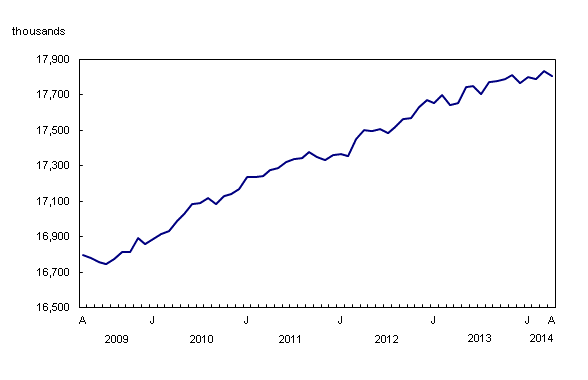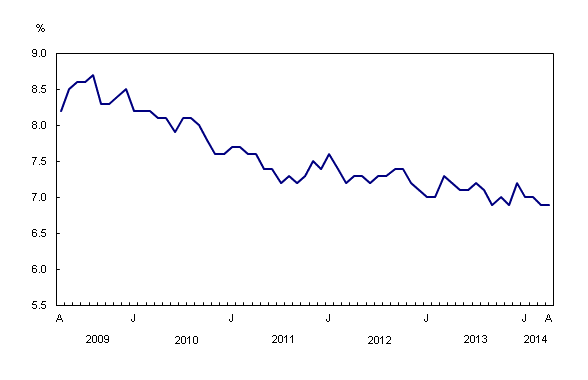Labour Force Survey, April 2014
Archived Content
Information identified as archived is provided for reference, research or recordkeeping purposes. It is not subject to the Government of Canada Web Standards and has not been altered or updated since it was archived. Please "contact us" to request a format other than those available.
Released: 2014-05-09
Employment decreased by 29,000 in April, and the unemployment rate was unchanged at 6.9% as the number of people participating in the labour market edged down. There has been little overall employment growth in Canada since August 2013.
On a year-over-year basis, the number of people working rose by 0.8% or 149,000, evenly split between part-time and full-time work.
In April, employment was down in Quebec, New Brunswick, Newfoundland and Labrador and in Prince Edward Island, while it increased in Saskatchewan.
Employment declined among women aged 25 to 54 and youths aged 15 to 24, while it increased among women 55 and over.
In April, there were fewer people working in accommodation and food services, as well as finance, insurance, real estate and leasing. At the same time, employment increased in business, building and other support services.
The number of hours worked fell 1.1% on a year-over-year basis, driven by a decline in April 2014 as Good Friday fell in the survey reference week and a number of workers took extra vacation time that week.
From April 2013 to April 2014, the participation rate fell from 66.5% to 66.1%, mainly the result of a decline in the participation rate of the population aged 25 to 54, the group most likely to participate in the labour market.
Adjusted to US concepts, the unemployment rate in Canada was 6.0% in April, down 0.2 percentage points from 12 months earlier. In the United States, the rate fell 1.2 percentage points over the same period to 6.3%.
Employment declines in Quebec and most of Atlantic Canada
In Quebec, employment fell by 32,000 in April. Despite this decline, the unemployment rate remained at 7.6% as fewer people participated in the labour market. Compared with a year earlier, employment in this province was virtually unchanged.
In April, there were 5,400 fewer people working in New Brunswick and the unemployment rate increased 0.8 percentage points to 10.5%. On a year-over-year basis, employment in the province was little changed.
Employment in Newfoundland and Labrador declined by 3,300 in April, and the unemployment rate was 12.1%. Compared with 12 months earlier, employment in this province was virtually unchanged.
The number of people working in Prince Edward Island fell by 1,200 and the unemployment rate was 11.7%. On a year-over-year basis, employment in the province was down 2,100 (-2.8%).
In Saskatchewan, there were 3,000 more people employed in April. At the same time, there were fewer people looking for work, pushing the unemployment rate down 1.1 percentage points to 3.4%. This was the lowest rate in the province since comparable data became available in 1976. Compared with 12 months earlier, employment in Saskatchewan was up 8,300 (+1.5%).
In April, employment was little changed in Ontario and the unemployment rate was 7.4%. On a year-over-year basis, employment in the province was up 74,000 (+1.1%), with most of the gains occurring at the beginning of the period.
Fewer women aged 25 to 54 and youths employed
In April, employment among women aged 25 to 54 fell by 29,000, bringing employment for this group to a level similar to that of April 2013. Among men in this age group, there was little change in employment in April compared with both the previous month and one year earlier.
Among youths aged 15 to 24, employment declined by 27,000 in April, but the unemployment rate was little changed at 13.4% as fewer youths participated in the labour market. Compared with 12 months earlier, youth employment was little changed.
Employment increased by 29,000 for people aged 55 and over, mostly women. Compared with 12 months earlier, employment among people in this age group rose by 139,000 (+4.2%). These gains were mainly the result of a 3.3% growth in the population of this age group.
Industry perspective
In April, there were 32,000 fewer people working in accommodation and food services, bringing employment in this industry down to a level similar to that of 12 months earlier.
Employment in finance, insurance, real estate and leasing fell by 19,000 in April. Employment in this industry was little changed compared with 12 months earlier.
Employment in business, building and other support services increased for the second consecutive month, up 26,000 in April, bringing employment gains in this industry to 38,000 (+5.5%) compared with 12 months earlier.
In April, there were 46,000 fewer people working as employees. On a year-over-year basis, the number of private sector employees increased by 1.7%, while the number of public sector employees edged down. Over the same period, self-employment was little changed.
Canada-United States comparison
Compared with 12 months earlier, the participation rate (adjusted to US concepts) fell in both Canada and the United States. In Canada, the participation rate declined by 0.4 percentage points to 66.1%, and in the United States, the rate fell by 0.6 percentage points to 62.8%.
In April, the unemployment rate in Canada (adjusted to US concepts) was down 0.2 percentage points to 6.0% compared with 12 months earlier. Over the same period, the rate in the United States fell 1.2 percentage points to 6.3%. The decrease in the US unemployment rate was driven by the decline in the participation rate. This was also true in Canada, but to a lesser extent.
In the 12 months to April, the employment rate in Canada (adjusted to US concepts) declined by 0.3 percentage points to 62.1%. This contrasts with the United States, where the employment rate increased 0.3 percentage points to 58.9% over the same period.
Note to readers
The Labour Force Survey (LFS) estimates for April 2014 are for the week of April 13 to 19.
The LFS estimates are based on a sample and are therefore subject to sampling variability. As a result, monthly estimates will show more variability than trends observed over longer time periods. For more information, see Interpreting Monthly Changes in Employment from the Labour Force Survey. Estimates for smaller geographic areas or industries also have more variability. For an explanation of sampling variability of estimates and how to use standard errors to assess this variability, consult the "Data quality" section of the publication Labour Force Information (Catalogue number71-001-X).
This analysis focuses on differences between estimates that are statistically significant at the 68% confidence level.
The employment rate is the number of employed persons as a percentage of the population 15 years of age and over. The rate for a particular group (for example, youths aged 15 to 24) is the number employed in that group as a percentage of the population for that group.
The unemployment rate is the number unemployed as a percentage of the labour force (employed and unemployed).
The participation rate is the number of employed and unemployed as a percentage of the population. For more detailed information, see the Guide to the Labour Force Survey (Catalogue number71-543-G).
Unless otherwise stated, this release presents seasonally adjusted estimates, which facilitates comparisons by removing the effects of seasonal variations. For more information on seasonal adjustment, see "Seasonal adjustment and identifying economic trends."
Each year, the LFS revises its estimates for the previous three years, using the latest seasonal factors.
A more detailed summary, Labour Force Information (Catalogue number71-001-X), is now available online for the week ending April 19. From the Browse by key resource module of our website under Publications, choose All subjects, then Labour.
Data tables are also now available online. From the Browse by subject module of our website, choose Labour.
The next release of the Labour Force Survey will be on June 6.
Contact information
For more information, contact us (toll-free 1-800-263-1136; 514-283-8300; infostats@statcan.gc.ca).
To enquire about the concepts, methods or data quality of this release, contact Vincent Ferrao (613-951-4750; vincent.ferrao@statcan.gc.ca) or Lahouaria Yssaad (613-951-0627; lahouaria.yssaad@statcan.gc.ca), Labour Statistics Division.
- Date modified:



